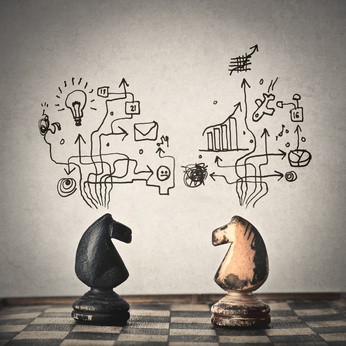
Conform to the norm
A sure sign that I've adapted to England, my country of residence but not birth, is that I find it impossible to jump queues. The mere idea causes me pain. That's despite the fact that queue jumping would save me time and usually draws no more than a few tuts for punishment (another very English behavioural trait). So why do I always patiently wait my turn?

Nobody likes queueing, but most of us do it.
The answer is that I've internalised the elaborate social norm English people have built around queueing. I don't so much follow it because I believe in the practical virtues of queues (though I do), but because I feel emotionally compelled to conform. We're all born with this capacity to internalise social norms, and it's easy to see why: norms are the oil that greases cooperative societies. Without them there would be chaos.
In evolutionary terms, however, there's a missing link. Life didn't start with an innate desire to stick to social rules. Our very early ancestors were out for their own survival. Since evolution through natural selection favours the fittest, it's hard to see how polite individuals who are happy to follow collective rules at their own expense would have survived. The same puzzle surrounds the evolution of any form of cooperation and of altruism. How did our ability to internalise social norms take hold?
A recent study addresses this puzzle using a favourite tool in the area: game theory. The idea is to look at life as a game in which each individual can make certain moves directed by clear rules. Individuals follow specific strategies, and those who do better are more likely to produce offspring than those who don't do so well. If you can describe all this in precise mathematical terms, you can use a computer to simulate thousands of generations and see which strategies die out and which thrive. A strategy that looks silly at first sight, such as sticking to norms that offer no immediate price or punishment, may turn out to be beneficial in the long run and over the generations become entrenched.
Sergey Gavrilets and Peter Richerson's game theoretical model involves lots of groups of hypothetical individuals. During its life time each individual has a number of chances (40 to be precise) to join in some collective action (such as forming a queue) or to refuse (to jump the queue). Since social norms aren't likely to take hold unless they are policed, individuals also get the chance to punish those who didn't take part.
Each time a social action comes around an individual is faced with four choices: take part and punish non-conformists, take part and don't punish them, don't take part and punish, and don't take part and don't punish. Gavrilets and Richerson describe the four choices using two variables: the variable $x$ describes the choice of taking part and can be either $0$ (don't take part) or $1$ (take part). The variable $y$ describes the choice of punishment and can also be either $0$ (don't punish) or $1$ (punish).
What's the price of not taking part?
Each of these four possibilities comes with a net pay-off for the individual that picked it. That's just as in real life: not taking part and not punishing norm-breakers might give you some advantage (barge to the front of the queue and grab the best piece) but a punishment (being beaten up) might diminish your gain. Your net pay-off then depends on how the advantage of dodging the norm compares to the disadvantage of punishment. Gavrilets and Richerson worked out a formula that determines the pay-off $p(x,y)$ for each of the four possibilities. It depends on a number of other parameters, for example a number measuring the benefit and cost of a social action, and a number measuring the cost involved in monitoring and punishing rule-breakers — we won't go into the details here, but you can see their paper to find out more.
Individuals can change their values of $x$ and $y$ during their life times, but there's also a parameter they don't choose themselves: that's their innate ability to internalise social norms, which depends on their genes. It is measured by an internalisation parameter $n$, which lies between $0$ (not at all able to internalise norms) and $1$ (very able to internalise norms). When an individual changes its values for $x$ and $y$ (whether they take part in a social action, and punish norm-breakers, respectively) they don't make their new choices randomly. Instead, they choose the values that maximise the expression \begin{equation}u(x,y) = (1-n) \times p(x,y) + n \times (v_1x + v_2y).\end{equation} The parameters $v_1$ and $v_2$ are fixed numbers greater than or equal to zero, which measure the maximum value you can derive by taking part in an action ($x=1$) and punishing ($y=1$) respectively. You can see that if an individual has $n=0$, so it's not able at all to internalise norms, then equation 1 becomes $$u(x,y) = p(x,y).$$ As you would expect, this individual will choose values of $x$ and $y$ that maximise its own pay-off $p(x,y)$ without worrying about others. If, on the other hand, an individual has $n=1$, then equation 1 becomes $$u(x,y) = (v_1x + v_2y).$$ In this case the individual doesn't care about their own pay-off and will always choose $x=1$ and $y=1$: take part in the action and punish. Someone with a value of $n$ in between $0$ and $1$ will choose whatever combination of $x$ and $y$ makes $u(x,y)$ as large as possible (though the model also accounts for the possibility that individuals might occasionally get this optimisation wrong). The function $u$ is called a utility function because it measures how much benefit — utility — individuals get out of their action. Gavrilets and Richerson started their society off with individuals all having very low values of the internalisation parameter $n$, between $0$ and $0.05$. They then set the games rolling, with groups of individuals facing 40 opportunities to take part in social actions. After each social action a proportion of all individuals (chosen randomly) choose new values for $x$ and $y$ in a way that maximises their utility function. After the 40 social actions their life comes to an end. Individuals then reproduce according to how well they did during their lives. Groups whose social actions were successful are more likely to survive. In each surviving group, the fittest individuals (where success and fitness are also measured by mathematical formulas) are more likely to produce offspring. When individuals reproduce they pass their internalisation parameter on to their children, though there's also a small chance that the parameter mutates to a different value.
Game theory looks at life as a game in which each individual can make certain moves directed by clear rules.

The top image shows how the proportion of individuals using different combinations of x and y changes over the generations. For example, the pink line represents the proportion of individuals using x=0 and y=0, the blue line represents the proportion of individuals using x=1 and y=0, and so on. The bottom image shows how the internalisation parameter n changes over the generations. The intensity of the black colour is proportional to the number of individuals with the corresponding value for n present at a given time. The red line shows the mean value of n. (These plots correspond to a particular combination of parameter values.) Figure from Collective action and the evolution of social norm internalization by Gavrilets and Richerson, published in PNAS.
Many of the simulations had intermediate values of $n$, but there were also societies that contained a small proportion of individuals with high values: heroes, local leaders, or perhaps fanatics who are willing to make huge sacrifices without regard for their own well-being. Similarly, there can be a small proportion of individuals with a very low value of $n$, who are completely unable to internalise social norms: psychopaths, perhaps.
As all game theoretical models, this one greatly simplifies our behaviour and the world we live in. It does show, however, that it's theoretically possible for the ability to internalise norms to evolve in a society where it was initially very low. Gavrilets and Richerson argue that this ability was "likely a crucial step on the path to large-scale human cooperation".
In our highly evolved society social norms of all shapes and colours have emerged. Some are obviously useful, some appear downright silly. Kate Fox's book Watching the English has an eye-opening collection, particularly for immigrants like me. But even if some norms are strange, we at least have an excuse for our meek observance of them: it's instinctive.
Comments
Steven
"We're all born with this capacity to internalise social norms" - have you heard of autism?
Rachel
Thanks for pointing that out Steven, it's a good point and interesting to think about. I guess what we meant to say is the majority of people are born with this capacity. For those people I know on the spectrum, they explain that they don't instinctively internalise these social norms, but some of them, sometimes out of necessity and sometimes out of choice, teach themselves how to follow these. We'll have a think about it and perhaps amend the article.